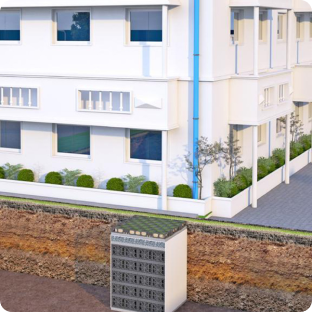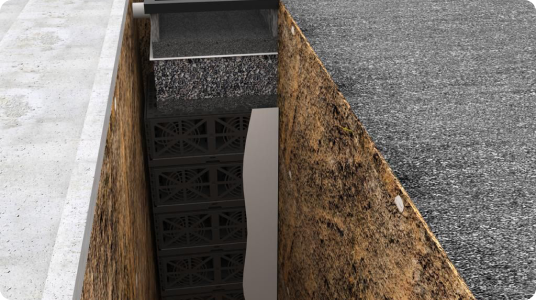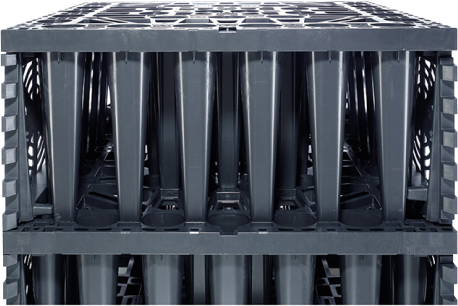Rainwater Harvesting Structures
Structures at Roads & Buildings




Structures at Public Parks and Playgrounds



STORM WATER DRAIN INLET SILT CATCH PIT WITH ECO BLOC RWH STRUCTURE

Stormwater management systems essentially function to manage surface runoff in urban areas where run-off cannot infiltrate due to the impermeable surfaces. Traditional stormwater management was mainly to drain high peak flows away. Unfortunately, this only dislocates high water loads. Modern approaches or the recent sustainable urban development solutions aim to rebuild the natural water cycle, i.e. to store runoff water (e.g. retention basins) for a certain time and to recharge ground water (e.g. infiltration tanks) which will eventually reduce the urban flood inundation. Such infiltration-based storm water management systems offer considerable solution on:

Proper drainage of surface run-off, Possibility to recharge groundwater, Treatment of storm water in a very early stage, Avoids damages on infrastructure (private properties, streets, etc.), Flood inundation prevention, Can be integrated into the urban landscape and provide green and recreational areas An innovative solution of “Integrated Strom water management and Tank system” by the use of German based ecoblocs (primarily “reused” poly propylene materials) is proposed for GCC. The basic component in the form of silt catch pit has been further remodeled with ecobloc based Rainwater harvesting cum Infiltration tank arrangement to recharge the groundwater aquifer.
This system was designed considering the core requirements
▪ Preventing pollution and easy maintenance.
▪ Minimize the development impact on hydrology.
▪ Source control of runoff water and not letting the rainfall runoff water leave the site
▪ Concept of integrated management practices (IMPs) through which rainfall will infiltrate, store and discharge the runoff into local waterbody/pond.
This method of Strom water managements and tank system has inbuilt rainwater harvesting arrangement. This method will increase groundwater recharge and store 3000 litres of storm water runoff and reduce urban flooding with increased design life. This will not allow sewage and act as a filter layer. This system has been proposed and constructed at every 30 m interval in the existing storm water drain network which will facilitate the rainwater harvesting, silt catch pit and demonstrate as managed groundwater aquifer recharge system. This solution helps to counter the problem of increased amount of land covered by building, car parks and roads which prevents rainwater from naturally infiltrating the ground which results in reducing the pressure off from the sewer networks and reduces the surface water drainage induced urban flooding

Further merits of installing this system are presented below:
- We listen to the other person without interruption and practice effective listening skills.
- We do not shy away from challenges.
- We stay true to our slogan.
- Flexible in geometry and Shortest possible installation time
- Process has modest dimensions, minimal dead weight, and is easy to maintain.
- High traffic load handling capacity of 60Ton
- Excellent ROI as design life is above 50 years
- Modular construction blocks-L800xW800xH360mm
- Flat installation depths possible along the roads.
- Surface is delivered back for use immediately after installation.
- Underground infrastructure is easily accommodated
- High storage volume -up to 96% of occupied volume.
- Backfilling and loading possible right after the installation.
- Ecofriendly product made from recycled raw material
photo & video



ROOFTOP RAINWATER HARVESTING

Rooftop Rainwater Harvesting (RWH) is the technique through which rainwater is captured from the roof catchments and stored in sumps, underground tanks, etc. Harvested rainwater can be stored in sub-surface ground water reservoir by adopting artificial recharge techniques to meet the water supply and groundwater recharge. The main objective of rooftop rainwater harvesting is to make water available for future use. Capturing and storing rainwater for use is particularly important in dryland, hilly, urban and coastal areas. Government of Tamil nadu made RWH as mandatory provision in all the buildings and infrastructure projects to harness the rainwater during rainy season to recharge the groundwater.
HYDROLOGY STUDY FOR THE DESIGN OF RAINWATER HARVESTING
The surface water management plan (SWM) was analysed considering the catchment/sub-catchment as planning unit. The delineated catchment was further sub-divided into sub-catchments. The SWM planning process has been derived based on the watershed consideration of analysing the quantum of runoff generated area ie., from the roof top areas, pavements, parking areas and from the landscape areas. Surface runoff is the flow of water occurring on the ground surface when excess rainwater, stormwater, meltwater, or other sources, can no longer sufficiently rapidly infiltrate in the soil. Runoff co-efficient is one essential factor for runoff contribution. The runoff coefficient (C) is a dimensionless coefficient relating the amount of runoff to the amount of precipitation received. It is a larger value for areas with low infiltration and high runoff (pavement, steep gradient), and lower for permeable, well vegetated areas (forest, flat land). As per CPHEEO manual, runoff co-efficient varies fully based on the existing condition of land types such as open space, agricultural land, Commercial, Industrial, bituminous Road, WBM & Water bodies etc.
